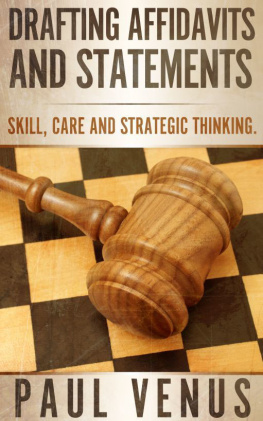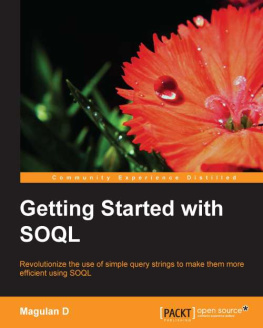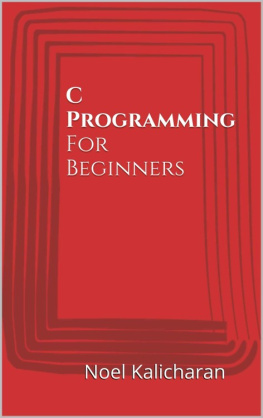Liz Sales - I Write Artist Statements
Here you can read online Liz Sales - I Write Artist Statements full text of the book (entire story) in english for free. Download pdf and epub, get meaning, cover and reviews about this ebook. year: 2018, publisher: Daylight Books, genre: Romance novel. Description of the work, (preface) as well as reviews are available. Best literature library LitArk.com created for fans of good reading and offers a wide selection of genres:
Romance novel
Science fiction
Adventure
Detective
Science
History
Home and family
Prose
Art
Politics
Computer
Non-fiction
Religion
Business
Children
Humor
Choose a favorite category and find really read worthwhile books. Enjoy immersion in the world of imagination, feel the emotions of the characters or learn something new for yourself, make an fascinating discovery.

- Book:I Write Artist Statements
- Author:
- Publisher:Daylight Books
- Genre:
- Year:2018
- Rating:3 / 5
- Favourites:Add to favourites
- Your mark:
- 60
- 1
- 2
- 3
- 4
- 5
I Write Artist Statements: summary, description and annotation
We offer to read an annotation, description, summary or preface (depends on what the author of the book "I Write Artist Statements" wrote himself). If you haven't found the necessary information about the book — write in the comments, we will try to find it.
I Write Artist Statements — read online for free the complete book (whole text) full work
Below is the text of the book, divided by pages. System saving the place of the last page read, allows you to conveniently read the book "I Write Artist Statements" online for free, without having to search again every time where you left off. Put a bookmark, and you can go to the page where you finished reading at any time.
Font size:
Interval:
Bookmark:
Table of Contents
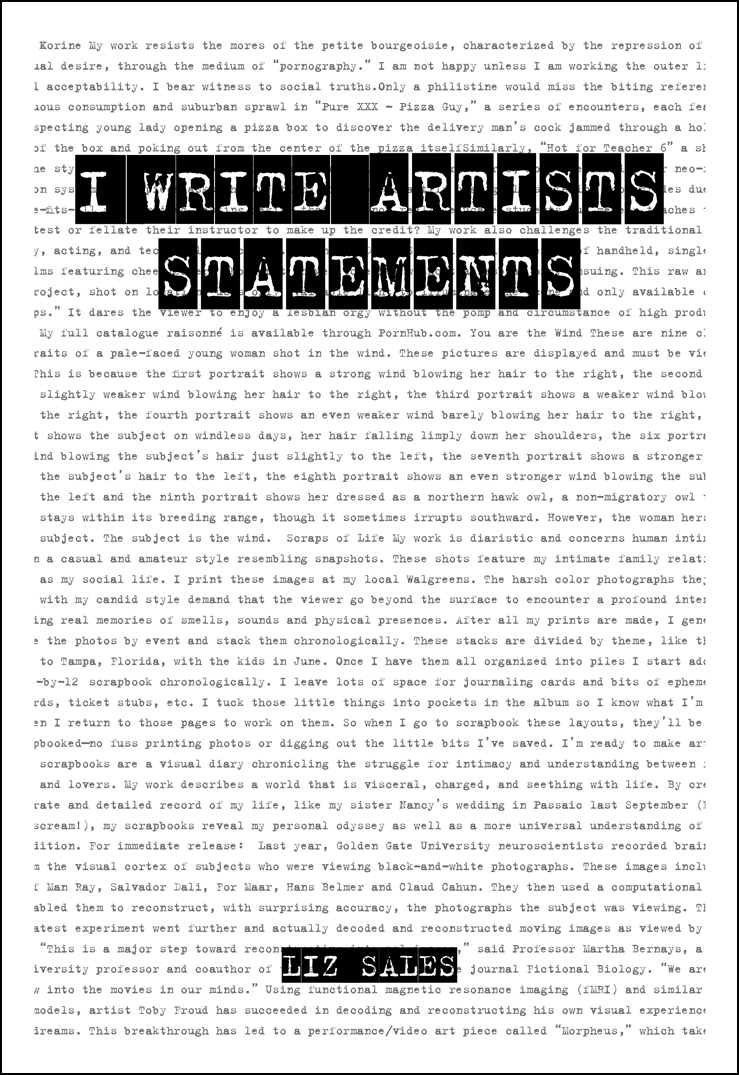


Cofounders: Taj Forer and Michael Itkoff
Creative director: Ursula Damm
Copy editor: Elissa Rabellino
2018 Daylight Community Arts Foundation
Text Liz Sales, 2017
All rights reserved.
ISBN 978-1-942084-60-0
No part of this publication may be reproduced, stored in a retrieval system, or transmitted in any form or by any means without the prior permission in writing of copyright holders and of the publisher.
Daylight Books
Email:
Web: www.daylightbooks.org
For Steve
Contents
Things that dont quite make sense can be most valuable tools.
David Wilson, director, Museum of Jurassic Technology
Truth may be stranger than fiction, goes the old saw, but it is never as strange as lies.
(Or, for that matter, as true.)
John Hodgman, The Areas of My Expertise (2005)
Beginning a written work with a succession of semi-obscure quotes is often a sign of insecurity.
Anonymous
At some point in their career, an artist will more than likely be involved in the process of writing an artist statement. They will often think this creation to be a simple task until they actually have to do it. The art of describing themselves and their work is not an easy feat. They will panic. They will sweat. They will, as Gene Fowler says, sit staring at a blank sheet of paper until drops of blood form on [their] forehead.
Everyone should try to write about their creative work. Writing is just an organized form of thinking, and thinking about your work helps you to make better work. However, many artist statements end up vague, lyrically romantic, verbose, obviously trying to impress with unnecessary vocabulary. Pompous things to avoid include too many quotations from philosophers, writers, or artists and too much technical talk. The point of an artists statement is not to provide the audience with a complete education or to highlight in jargon all the complicated aspects of a manual that most folks cannot comprehend. Its challenge is to distill and clarify an artists intention in an accessible way through language. Who are you? What did you make? How did you make it? And why is that important to you? People are interested in other people, and their narratives and the statements should be welcoming.
Liz Sales is an artist, and also a go-to person to help navigate this system. She has provided assistance to countless other artists who feel that making work and being able to write concisely and articulately about it are two entirely different skill sets. In this little paperback, Liz uses her understanding of the structure of the artist statement to construct statements for fictional photo-based artists that satirize art school, gallery, and popular photography clichs, as well as describe impossible projects that simply could not exist off the printed page.
Matthew Carson, head librarian and archivist, International Center of Photography
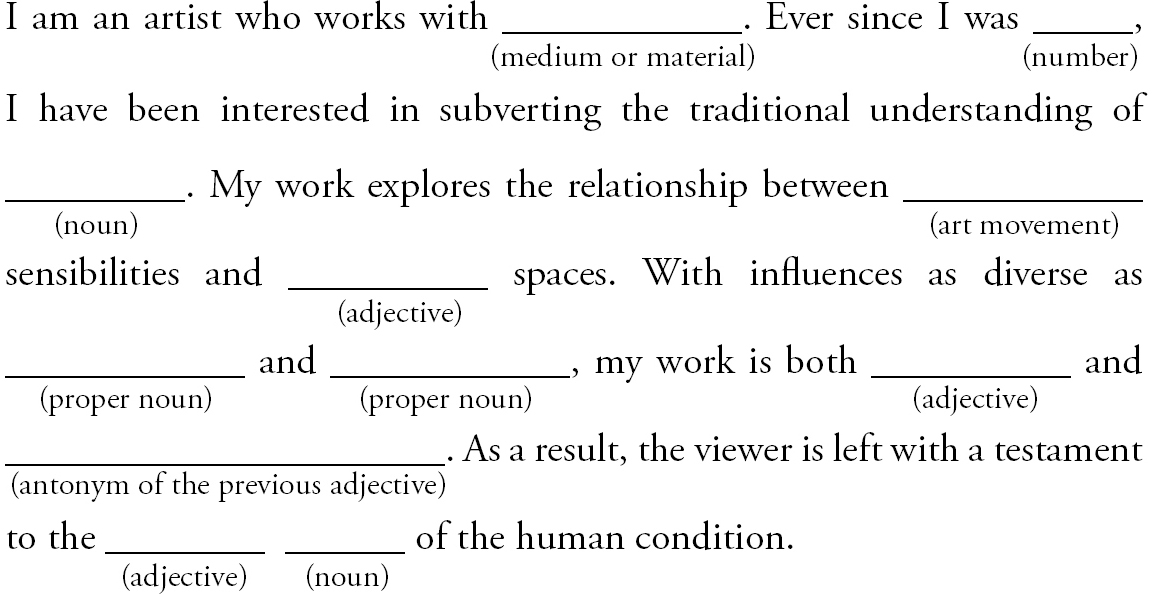
Martin Shear is a self-taught artist who works as a custodian at an elementary school in Nashville, Tennessee, by day and paints, from photographs, on small, pre-stretched canvas in acrylic by night. His familys home is filled with dozens and dozens of paintings that measure 8 10 inches, as well as a handful of even smaller ones placed on shelves. Some of these paintings are made from postcards depicting the Nashville skyline, because the skyline is pretty and familiar, while other paintings depict his wifes guitars because he likes painting guitars and Betsy owns quite a few.
Like other artists who have chosen to live far from the Chelsea galleries, he regularly posts his paintings on Facebook and Instagram. His paintings are just the right scale for documenting with his Samsung Galaxy 6 and posting on social media sites. Friends and strangers see and like his work: they give him encouragement and, sometimes, they reach out to him about purchasing a piece. Essentially, Shear is happier than you are. Youre way too fucking precious about your work.
These stunning images of sidewalk litter shot in nature highlight our undeniable impact on the environment, including the urban environment. My interest in repurposing trash in the service of art began on the day I volunteered to chaperone my sons Cub Scouts troop on their community service day, collecting litter. While the boys removed the refuse from the sidewalk, placing it in trash and recycling receptacles, I watched, struck by the beauty of a crushed Fanta can backlit in the gold tones of the early morning light.
I began transforming garbage into art. I shot cigarette butts, straws, latex balloons, Styrofoam cups, used condoms, and an old set of flip-flops, leaving each where I found it. These images bring attention to the environmental issue of trash, beautifully rendered trash. All the items imaged began as useful objects, but as a result of human behavior, negligence, or forgetfulness, they ended up on the street. I transform this trash into art with an important message: I am a special person who sees beauty everywhere.
Fans of my street photography often ask me, Is that real, or did you use Photoshop? I do not mess with nature. I create art. I am a photographer who posts final images straight from my camera to Flack Photos Facebook page. These images are true in the truest sense and fully express who I am and what I see in the most literal sense. When I take a picture of a seagull soaring over Bay Harbor, I am not speaking about elevated consciousness or self-confidence or whatever else youve written in my comments section; I am taking a great picture of a bird, by panning my camera along in time with this moving subject so that the bird is a relatively sharp subject but the background is blurred. Panning is a technique that can produce amazing results if you perfect it, which I have.
Some say the term photographer fails to accurately describe the vast majority of artists working with cameras. These people are wrong. A real photographer is able to perfectly capture the scene in front of him and share it with his online community. If he is honest and open, he will also share his ISO, aperture, and shutter speed. This technical information is the artists real artist statement. Artist statements as the liberal elite are taught to write them, in their nurseries of higher learning, add nothing to the photographic image, which should speak for itself.
May the light be with you!
Gustav M. Christoffersen (b. 1992, Oakland) is a space artist who creates photo-based pulp sculptures as an architectural stage for his social practice, which is concerned with the narrative of cyclical realities. Christoffersen urges us to renegotiate physical realities as being part of oppressing themes in our post-contemporary, image-based society. By choosing formal non-solutions, he creates hyper-personal moments born by means of omissions, refusal, and Elmers glue. He invites the viewer round and round in circles of photographic sculptural matter. He manipulates these structures in order to deconstruct socially defined spaces and their uses and post-possibilities.
Multilayered conceptualism arises in which the fragility and instability of our seemingly real reality is queried. The results are deconstructed so that meaning is soaked in possible interpretations of impossibility. With an under-conceptual approach, he creates with daily, recognizable photographic imagery an unprecedented situation in which the viewer is shown the conditioning of his or her own image space and has to reconsider their own life.
Next pageFont size:
Interval:
Bookmark:
Similar books «I Write Artist Statements»
Look at similar books to I Write Artist Statements. We have selected literature similar in name and meaning in the hope of providing readers with more options to find new, interesting, not yet read works.
Discussion, reviews of the book I Write Artist Statements and just readers' own opinions. Leave your comments, write what you think about the work, its meaning or the main characters. Specify what exactly you liked and what you didn't like, and why you think so.




